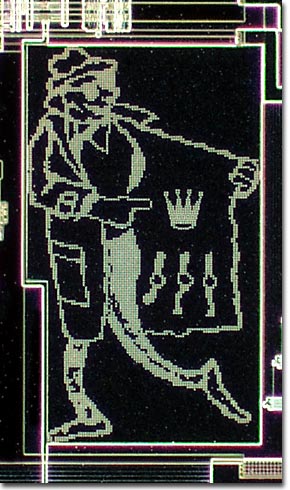The Con Artist (Darkfield)
|
We found this interesting creature on the Hewlett-Packard superscalar PA-RISC 7100LC Hummingbird microprocessor chip not far from the hummingbird (you know---the one that is for you). The guy with the sunglasses appears to be showing a number of items, including some (probably) "hot" watches, inside his trench coat. From the crown advertisement on the inside of his coat, we think that this guy expects us to believe they are genuine Rolex watches. Although we don't understand the significance of this scam artist or whom he expects to con while lurking around on this chip, he is one of our most unusual busts to date. It's characters like this that lead us to suspect that a secret cartoon culture is being perpetuated on hidden silicon. Several emails from HP engineers Patrick Knebel, Wayne Kever, Craig Robson, and Bob Miller have cleared up the mystery of this con artist. Early HP chipsets included a separate floating-point math coprocessor, and the HP-9000/720 workstations used a Texas Instruments chip that was termed the "Timex" coprocessor. In later microprocessors, HP integrated the floating-point unit onto the CPU die. The PA-7100 microprocessor contains the "Rolex" floating-point circuitry integrated onto the chip, and this advanced circuitry features greater performance than the Timex coprocessor. The clock circuitry was later redesigned to save space (modestly reducing double-precision performance) on the PA-7100LC (Low Cost) processor and the floating point array was then nicknamed "Lorex", a pun on the low-end Rolex. The con artist (designed by HP VLSI design engineer Bob Miller) was placed on the PA-7100LC with a modified Rolex crown that is missing a point (it only has four), to symbolize the cheap Rolex knock-offs, "Lorexes" that he is apparently trying to pawn. Another interesting feature of the con artist is the unusual way this creature was created on the chip. The vast majority of silicon creatures are created as "wireframe" metal layers on a silicon dioxide surface. The con artist was constructed in a series of small squares, much like a bitmap image. The technique using these small squares is the safest technique that engineers have for patterning these miniature doodlings. The actual squares are really contacts (voids where a hole is produced in the dielectric medium) between two metal layers and appear as a series of slight dents in the surface of the chip. This is demonstrated with our Yin Yang interactive Java tutorial that illustrates how these doodles are formed on the surface of an integrated circuit. and brightfield illumination. |
© 1995-2025 by Michael W. Davidson and The Florida State University. All Rights Reserved. No images, graphics, software, scripts, or applets may be reproduced or used in any manner without permission from the copyright holders. Use of this website means you agree to all of the Legal Terms and Conditions set forth by the owners.
This website is maintained by our
|
